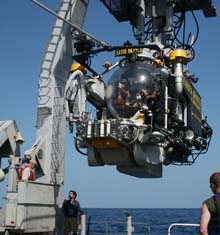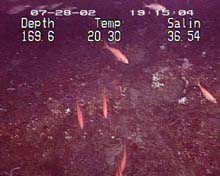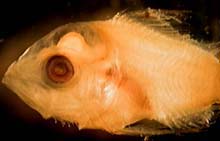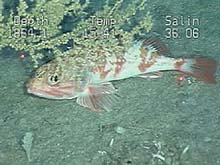
Seated in “The Bubble,” Dr. Leslie Sautter and Pilot Craig Caddigan hover in the air as the crew launches the JSL II. This begins the second dive on Jacksonville Scarp. Click image for larger view.
Diverse Patterns of Reef Fish Reproduction
July 30, 2002
David M. Wyanski & John C. McGovern
Marine Resources Research Institute
South Carolina Department of Natural Resources
![]() Watch a video of a scamp grouper rapidly changing color, reflecting its behavior. (mp4, 1.8 MB)
Watch a video of a scamp grouper rapidly changing color, reflecting its behavior. (mp4, 1.8 MB)
Today we are diving on Jacksonville Scarp, a reef 30 miles north of the St. Augustine Scarp dive sites conducted on July 28th. During the morning dive (#3291) on the Johnson-Sea-Link II, Dr. Charlie Barans observed that the currents in this area are stronger. In the areas adjacent to the reef, a stronger current leaves a thinner layer of sand overlying the limestone rock. This made it difficult to find places with enough sand to use the sediment grab. The field of large boulders below the top of the scarp is narrower, and the abundance of fishes is lower than on the reef off St. Augustine. However, we are seeing many of the same species, such as vermilion snapper, greater amberjack and a type of grouper called scamp.
Fishes associated with reefs off the Atlantic coast of the southeastern U.S. exhibit a wide variety of reproductive patterns. To illustrate the diversity of reproductive patterns, let’s consider three species that we see during submersible dives: 1) vermilion snapper, 2) scamp, and 3) blackbelly rosefish. The vermilion snapper is a gonochorist, which means that an individual is the same sex all of its life. Females begin to spawn at an age of two years and at a size of 6.5 inches (165 mm) fork length. In the final stage of oocyte (the term for an egg prior to release from the body) development, body fluid enters the oocyte, causing the egg volume to approximately double. The purpose of hydration is to decrease egg density so that after fertilization the egg will rise to the surface of the water column where a better food source is available for larvae. The presence of hydrated oocytes in the ovary is one of the criteria that we use to classify an individual as being in spawning condition.

Schools of vermilion snapper are common on reefs off the southeastern U.S. Click image for larger view.
Like most reef fish species, the eggs of vermilion snapper are fertilized outside the body of the female and develop in the water column. The eggs as well as the larvae that hatch from the eggs drift with the currents at the surface of the water. After one day, the eggs hatch, and at 30 to 40 days old, the larvae settle to the bottom. Small organisms such as fish eggs and larvae that drift in the water with limited mobility are called plankton. During our mission, we will be deploying plankton gear consisting of fine-mesh nets fixed to frames to catch the eggs and larvae of vermilion snapper and other reef fishes.
In contrast to the gonochoristic vermilion snapper that has separate sexes throughout its life, a grouper called scamp changes sex. It is a protogynous hermaphrodite, which means that it begins life as a female and later becomes a male when it is older and larger. A female scamp begins to spawn at an age of one to four years and at a size of 12 to 18 inches (300-450 mm) long. After spawning as a female for two to eight years, perhaps longer, this fish will begin to change sex, and become a male. The cues that initiate sex change are not well understood, but sex change in an individual is probably influenced by the presence or absence of other males and females in its surroundings. During the first submersible dive of the cruise, Chief Scientist Dr. George Sedberry observed a scamp exhibiting the gray-head color phase and acting aggressively toward another scamp. This behavior may have been related to spawning or sex change.

Larvae of at least three species of snapper (Lutjanidae) could be captured during this cruise leg. Click image for larger view.
Unlike vermilion snapper and scamp, which reproduce via external fertilization, the eggs of blackbelly rosefish are fertilized within the female. Early-celled embryos are later released into the water column. This reproductive pattern is found in only two families of bony fishes throughout the world—the scorpionfishes (Scorpaenidae) and the eelpouts (Zoarcidae). Another unusual aspect of reproduction in blackbelly rosefish is the delay of one to three months between insemination and fertilization. Sperm are stored in crypts in the ovaries until the oocytes are fully developed. Then fertilization takes place.
A good understanding of spawning in reef fishes is essential for fisheries management. Prior to the 1980s, very little was known about the life history of reef fishes in our study area. We now know that some species, groupers for example, have special requirements,. For instance, they must migrate to specific habitats or geographic locations to reproduce. Knowing this type of information is critical when making decisions on what habitat to protect. The South Atlantic Fishery Management Council currently is evaluating whether marine protected areas can be an effective method of sustaining fish populations. Additionally, we need to know if hermaphroditic species are more vulnerable to overexploitation than gonochoristic species. Nearly all stock assessment and management techniques to date have been developed for populations of gonochoristic species with equal numbers of females and males that are similar in size. Populations of protogynous hermaphrodites usually have far fewer males, and the males are larger than the females.
Submersible dives on some of the habitats frequented by these species will help us to better understand reproduction in reef fishes. Furthermore, we will be better able to describe the habitat and characteristics of the water that are essential for the survival of these many intriguing species. During the submersible dives at dusk this week, we hope to see vermilion snapper and scamp spawning.
Sign up for the Ocean Explorer E-mail Update List.















































